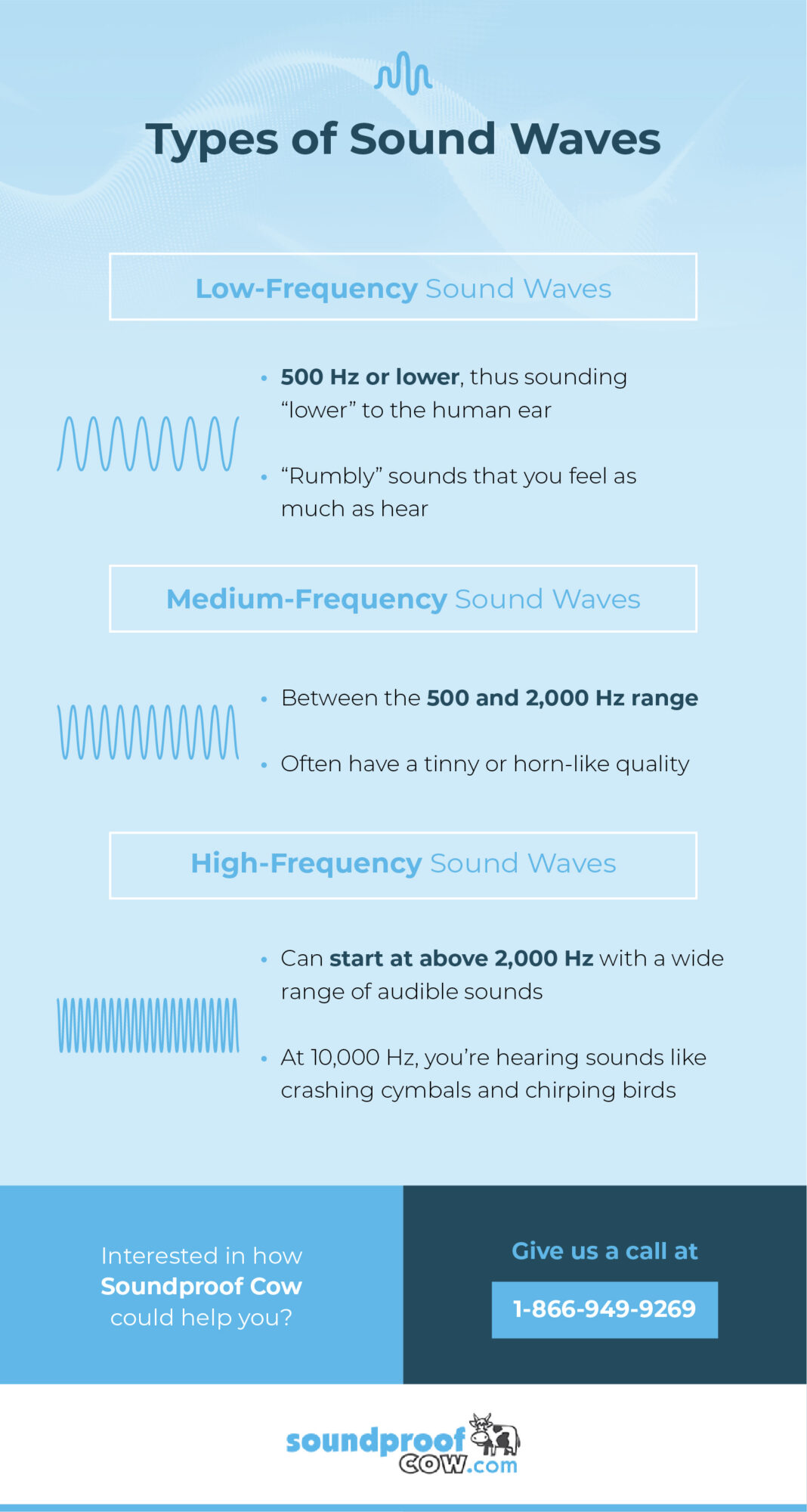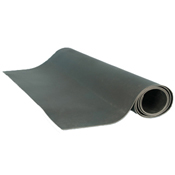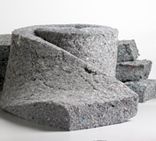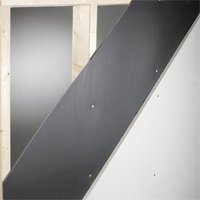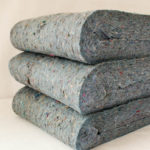
You’re probably aware that different sounds have different frequencies, but what are they? What’s the difference between high and low-frequency sounds? And what about middle-frequency sounds? If you’ve been wondering about the differences between sounds of varying frequencies and how they affect you, read on.
What Is The Frequency of A Wave?
The frequency of a wave refers to the number of cycles or vibrations of the wave that occur in a given unit of time, often in Hertz (Hz).
What Is Low-Frequency and High-Frequency When It Comes to Sound?
When we talk about sound, we talk in terms of high and low-frequency waves. Sound waves are movements of air molecules that our ears translate into sound, and frequency refers to the number of cycles these waves complete in a second. This measurement of cycles per second is expressed in Hertz (Hz), with a higher Hz representing higher frequency sound and a lower Hz representing lower frequency sounds. .
Human ears can register sounds from about 20 Hz in frequency up to 20,000 Hz, depending of course, upon the hearer. People with hearing loss usually have trouble hearing sounds in the higher frequency range. Speech usually falls within the 100 and 8,000 Hz range. People may start having difficulty discerning speech once it exceeds about 3,000 Hz-4,000 Hz.
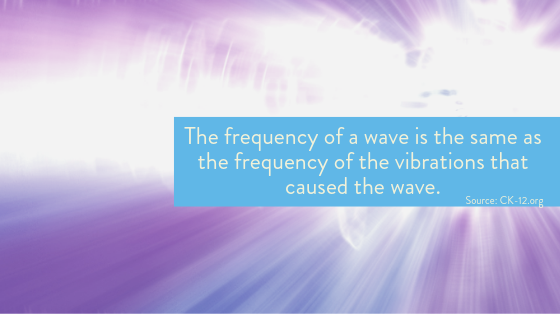
Types of Sound Waves
There are three types of sound waves, in general:
Low-Frequency Sound Waves
Low-frequency sound waves reside at and below 300 Hz. We perceive these sound waves to have the lowest pitch. Low-end noise comes with a longer wavelength, making it some of the most resilient. Low frequencies travel great distances and pass through walls more than others.
The human ear struggles to register waves with low frequency the closer they get to 20 Hz. We often feel low frequencies more than we hear them. As an example of a low-frequency noise, turning up the bass on a speaker system will cause the rafters to rumble, and you’ll feel it in your bones. As a result, low-end noise creates a sense of fullness that makes a movie’s audio sound realistic or a song’s mix lift you to your feet.
View this post on Instagram
Middle-Frequency Sound Waves
Middle-frequency or medium-frequency sounds range from 300 Hz to 2,000 Hz. Most of the noise we perceive on a daily basis is in the middle range. Everything from a person’s voice to a dog’s bark or a guitar’s strumming falls into this category.
Middle-frequencies are the basics of the sounds we perceive. They provide most of the information our ears need to discern a sound. Low- and high-end sound enhances middle frequencies by adding depth and clarity.
View this post on Instagram
High-Frequency Sound Waves
High-frequency sounds are those that range from 2000 Hz and beyond. Sounds at the high end of the spectrum add presence or clarity to noise. While a person’s voice mostly falls into the middle range, details like semblance and consonance are high-frequency noises. Other sounds that fall into the high-frequency category include birds chirping, sirens wailing, doors creaking, cymbals crashing and fans humming.
Because high-frequency noise comes with a short wavelength, it is the first to fade as sound travels over a great distance or through a dense surface. However, high-frequency sound can be the most noticeable when you’re in the room with it. Shrill, ear-piercing noises that hurt to hear are always high-pitched frequencies.
View this post on Instagram
Low- vs. High-Frequency Waves
It may help to think of low-, middle- and high-frequency sound with respect to musical notes.
The lowest note on musical instruments like organs, tubas, pianos and cellos are all in the 5-70 Hz frequency range. Middle C in the treble clef of a piano is a medium sound frequency sound, just a little above 500 Hz. The highest note on a flute is at the low end of the high-frequency range, about 2100 Hz, while the highest note on a standard piano is a little over 4000 Hz.
In terms of your stereo, when you turn up the bass, you’re filtering out the high-frequency sound and getting more low-frequency sound, and when you turn up the treble you’re getting more of the high frequencies.
View this post on Instagram
How to Treat Different Frequencies of Sound
Sound waves have unique qualities depending on their wavelength. That’s why it’s important to use a soundproofing approach that’s specific to the range you want to address. High-pitched sounds are more likely to reflect off of a surface, causing an echo. Meanwhile, low-pitched and mid-low noise will more easily permeate a solid surface. Here are a few ways to treat different frequencies of sound.
Sound That Passes Through Surfaces
Sound travels in the form of a wave that vibrates through the air. But air isn’t the only medium sound can pass through — it goes through solid surfaces, too.
Sound can use the particles in the air as transportation mediums, along with any solid surface. The difference is in the density. It takes more energy for sound to pass through a dense medium like a wall than a thin one like the air.
Frequencies of sound can pass through your walls, making it difficult to keep noise in or out of a room. Preventing noise transfer is all about increasing the density of the surface that you want to contain the sound. Building thicker walls or adding heavy materials to them will make it more difficult for sound to permeate.
You can also prevent noise transfer by absorbing sound energy. Absorptive materials soak up sound energy so there’s less to pass through the walls, floors and ceiling.
Sound That Reflects off Surfaces
A sound wave will continue traveling in a given direction until it contacts something like a wall to stop it. When the sound wave reaches a wall, it will bounce off and reflect at an angle, causing an echo. Echoes muddle noise, making it difficult for your ears and brain to decipher it. You can prevent or control echoing through sound diffusion or absorption.
Sound diffusion is the process of dispersing noise when it reaches a surface so it reflects evenly throughout the room. Sound diffusion materials feature surfaces at numerous sizes and angles to optimize the way sound reflects.
Sound absorption seeks to prevent reflections entirely by using materials that absorb the sound wave’s energy. Absorptive materials are soft and porous, so the sound wave has somewhere to go.
Sound That Escapes Through Cracks
Sound will find any avenue out of a space, even if it has to work through the smallest cracks. If there is a hole or gap in your room, sound can wiggle through regardless of the frequency.
You can prevent high, middle and low frequencies from escaping by plugging any hole or gap you find in the room. Check to see if there are gaps around your doors or cracks in the walls. Covering gaps and sealing cracks will contain more noise.
Sound From Structural Vibrations
Loud noise, especially low frequencies, will shake your floors and rafters. When a long, loud sound wave works through a surface and encounters loose objects, it will transfer its vibrations into anything it touches. Sound dampening offers a way to minimize vibrations. For instance, you could dampen a rattling pipe by fitting a soft material over it tightly. If your floorboards rattle, placing a soft material between the floorboards and joists can dampen vibration.
The Best Materials to Block Sound Waves
As you implement noise treatment solutions for low-, middle-, and high-frequency noises, now that you know what frequency in sound is, using the right materials will improve your results. Here are three materials that will enhance your noise treatment project.
Quiet Barrier® Mass Loaded Vinyl (MLV)
Adding mass and increasing density will solidify any surface’s defense against noise transmission. As you soundproof your home or office, use Quiet Barrier® Mass Loaded Vinyl to get the best results. MLV sheets install between layers of drywall to improve a structure’s absorption and dampening capabilities.
Quiet Batt® Soundproofing Insulation
Another material that will help you address noise across the frequency spectrum is Quiet Batt® Soundproofing Insulation. Quiett Batt® is a cotton fiber material with properties that absorb and dampen sound. When you install Quiet Batt® inside your walls or ceiling, the cotton fibers will catch any sound that attempts to pass through. Meanwhile, Quiet Batt® offers the softness and density needed to dampen structural noise.
Green Glue Noiseproofing
When installing acoustic materials, use Green Glue Noiseproofing Compound to finish the job. Green Glue is a nontoxic substance that binds materials together while adding a dampening effect. The substance acts as a buffer between the materials it binds while it converts mechanical energy to heat. Apply Green Glue between two layers of drywall for a fast, effective solution for your adhesion and sound-dampening needs.
Purchase Soundproofing Materials
Soundproof Cow is here to help you find the right materials and methods to use when addressing any kind of noise across the frequency spectrum. We offer a wide range of soundproofing products and can help you determine the best ones to use for your situation. For more on our soundproofing solutions and how you can apply them in your space, submit a free acoustic analysis form today!



